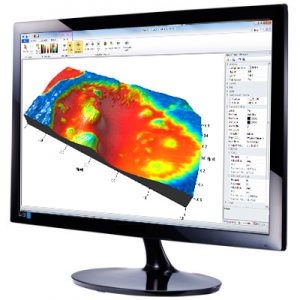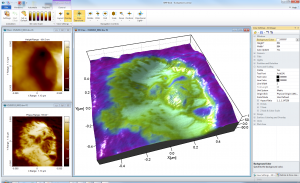Scanning Probe Microscopy
Image Metrology’s founder, Dr. Jan F. Jørgensen recently gave an interview discussing the field of Scanning Probe Microscopy, which below is re-produced for the knowledge of SPIP™ users.
The SPM Technique

Scanning Probe Microscopy or SPM, is a technique that uses a very sharp probe to scan over a surface in a raster pattern. When the probe is within atomic distance of the surface an AFM (Atomic Force Microscopy) probe can sense the repulsive and attractive forces from the surface. The height of the probe is controlled such that the force is kept constant meaning that also the distance to the surface is kept constant. Therefore, a topographic landscape image can be produced by recording the z position of the probe for the x, y positions.
Effectively the AFM probe traces over the surface of a substrate and records the surface topography as it does so.
Scanning Tunneling Microscopy
STM (Scanning Tunneling Microscopy) works in a similar manner to AFM but uses a different sensing method. In STM there is a bias voltage set between the probe and the surface and when in atomic distance to the surface a tunneling current can be measured by the probe.
Because both of the techniques involve scanning very close to the surface it is possible to obtain images with atomic resolution.
The SPM Advantages

The big advantage of SPM techniques compared to optical techniques is the ability to obtain height information and the unique capability of obtaining images at atomic resolution. SPM allows a lot of geometrical information to be extracted at a very detailed level.
To obtain geometrically correct images it is crucial that the movement of the probe relative to the surface can be controlled better than the desired resolution, which is a big challenge. It is almost impossible to create images where the pixels are acquired equidistantly and where there is no coupling between the axes. Even in the most perfect instrument problems with environmental noise, vibration and temperature changes will lead to imperfect images.
In SPIP™ we have implemented several methods to characterize imperfections and correct for them which allows extremely accurate measurements to be performed.
ABOUT Image Metrology
Image Metrology has been a subsidiary of Digital Surf since June 2014. Together with our mother company we develop advanced software for processing and analyzing microscopy images at the nano- and microscale. We are a highly innovative company constantly developing new solutions in order to meet the demands from our high-tech customers.
Company history
Image Metrology A/S was founded in 1998 by Dr. Jan F. Jørgensen who developed the SPIP software as part of his industrial PhD project in cooperation with IBM Denmark, the Danish Institute of Fundamental Metrology and the Technical University of Denmark. Today, the company is a leading supplier of image processing software for “nano-microscopy”.
In June 2014 Image Metrology was acquired by Digital Surf and now together working on MountainsSPIP® , the next generation of SPM image analysis software, based on the industry-standard Mountains® platform and all the best SPIP™ interactivity and analytical tools.MountainsSPIP® was first time released July 2019 and has replaced SPIP™. MountainsSPIP® is marketed by Digital Surf.
In January 2019 the company moved to new facilities at DTU Science Park in Lyngby close to Copenhagen.
After the launch of MountainsSPIP®, SPIP™ was taken off the marked in January 2020.
Company mission
It is to provide the customers with state-of-the-art image processing software for microscopy including:
- Correction tools for creating the most accurate presentation of the “true” surface
- Automated analysis techniques assuring high accuracy, quality and cost efficiency
- Visualization and reporting tools enabling convincing and impressive communication of results
The development and research work is done in collaboration with Digital Surf and international partners with the goal to deliver new innovative functions for MountainsSPIP®









